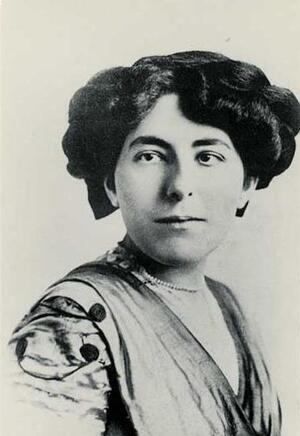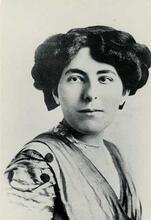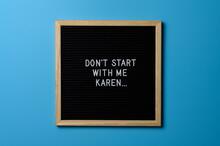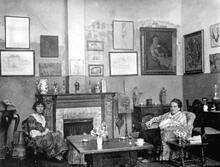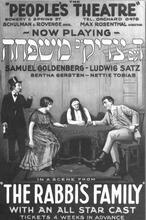Edna Ferber
Edna Ferber quit school at seventeen to become a reporter for the Appleton Daily Crescent in Michigan, moving to a larger paper in Milwaukee before turning her focus to fiction. In 1925, her novel So Big won the Pulitzer Prize, and her 1926 novel Show Boat, adapted into a musical, continues to hold a significant and controversial place in American culture. Ferber’s 1952 novel Giant was the basis for the 1956 movie of the same name starring Elizabeth Taylor, James Dean, and Rock Hudson. Ferber’s work was shaped by her childhood experiences of antisemitism in Iowa, and her work celebrated America even as she exposed its shortcomings. Her writing reflected her profound love of justice, and she often wrote about women whose energy and talent made them successful in business.
Overview and Early Life
A dedicated writer for more than fifty years, Edna Ferber was born in Kalamazoo, Michigan, on August 15, 1885. She celebrated America even as she exposed its shortcomings. Her published work includes twelve novels, twelve collections of short stories, two autobiographies, and nine plays—most in collaboration with other playwrights. Ferber’s novel So Big won a Pulitzer Prize in 1925, while the film Giant and the musical Show Boat, based on her novels, continue to entertain contemporary audiences. World famous in her time, Ferber was, for her readers at home, a beloved chronicler of American working people whose ethnic variety, linguistic idiosyncrasy, toughness, occasional sweetness, and resilience never ceased to fascinate her.
Edna Ferber’s enduring love of America and its workers—as well as the form that this passion gave to her life and work—rose, paradoxically, out of a childhood troubled by frequent moves from one state to another; by the business failures and the early blindness and death of her Hungarian-born father, Jacob Ferber; by the labor of her American-born mother, Julia (Neumann) Ferber, in several family stores; and by a period of seven years in which, Ferber remembered, there was never a day in which she was not called a “sheeny.” From age five to twelve, Ferber lived with her parents and older sister, Fannie, in Ottumwa, Iowa—a town so brutal toward Jews that she held it accountable until the end of her life for everything in her that was hostile toward the world. As Ferber carried lunch to her father every day, she had to run a gauntlet of antisemitic abuse from adult male loungers, perched on the iron railing at the corner of Main Street, who spat, called her names, and mocked her in Yiddish accents. Ferber’s parents suffered as well. Her father lost a lawsuit against an employee accused of theft when witnesses who had sworn to the truth of the accusation suddenly, in the courtroom, reversed their testimony.
Jewish Identity and Experiences of Antisemitism
Ferber herself described the effects of those seven years in various ways. She believed they were “astringent, strengthening years whose adversity” had toughened her. She understood that her terror of legal complications in the course of her writing career—as well as her profound love of justice—owed much to that early experience of injustice. Ferber’s sense of herself as a Jew and her adult responses to antisemitism were also shaped by the pain of those years. Like the five-year-old child who “didn’t run” but “glared” at her oppressors, Ferber confronted directly and caustically the antisemitic comments that occasionally marred her adult professional relationships. Her first autobiography, A Peculiar Treasure (1939), rings with contempt and rage against Hitler for making of Europe a world she could not recognize, in which it was no longer possible to love the human race.
Ferber believed that her identity as a Jew owed more to persecution and to her love of her family than to religious observance or historical tradition. She suspected that, as a child, her pride as a Jew might have reflected her pleasure in self-dramatization, in feeling herself “different and set apart,” in knowing herself to be superior to her persecutors. That sense of superiority stayed with her. As late as 1934, Ferber celebrated the absence of Jewish names among the “despoilers of America”—“paper mill millionaires” and others who had profited from the destruction of America’s forests and rivers. In time Ferber even developed a sense of collective Jewish identity that highlighted the positive compensatory effects of oppression. She believed that the Jew, left in peace, would have lost his “aggressiveness, his tenacity and neurotic ambition.” More important, oppression had yielded to Jews the priceless gift of “creative self-expression.” Jewishly uneducated, she knew nevertheless of “an old A member of the hasidic movement, founded in the first half of the 18th century by Israel ben Eliezer Ba'al Shem Tov.Chassidic book” that “says there are three ways in which a man expresses his deep sorrow: the man on the lowest level cries, the man on the second level is silent, but the man on the highest level knows how to turn his sorrow into song.” As a writer, Ferber cherished that knowledge all her life.
At first Ferber sought her own path toward “creative self-expression” in the theater. She called herself “stage-struck,” a passion nourished not only by her grandfather’s puppet plays, by her grandmother’s daily reenactments of encounters with tradesmen and neighbors, and by “playing show” with her sister, but also by the Ferber family’s frequent attendance at local performances in Ottumwa. Minstrel shows and shoddy traveling theater companies, as well as the earliest versions of what would become movies, dazzled the child. The adult recognized that they afforded “color, escape, in that dour unlovely town.” In time Ferber’s collaborations with George Kaufman and Jerome Kern on such plays as Dinner at Eight, The Royal Family, and Show Boat produced successes that gratified her lifelong love of theater.
Writing Career
At age seventeen, however, Ferber abandoned her plans to become an actor to help support her family. They had left Ottumwa for Appleton, Wisconsin, in 1897. Forbidden to study elocution when she graduated from high school, Ferber stomped out of her house and into the office of the Appleton Daily Crescent, where the editor hired her as a reporter. Thus, in a moment of stormy reaction, Ferber ended her formal education and entered the profession that was to engage her for the rest of her life. Although she would come to know very well the drudgery and loneliness of a writer’s life, and although she sometimes worried that the “gift of writing” might be taken from her at any moment, she cultivated that gift by habitually transforming every detail of sensory and emotional experience into words. The sounds of hangers striking one another in a moving train, the musings of a lonely teenager feeling sorry for herself, the graceful movement of a young gardener as he turned from his work, all went into storage in her imagination, to be pulled out like the spangles and feathers of an antique costume from a trunk in the attic when her stories required them. In love with the work of reporting, she moved from the Appleton paper at age eighteen to a larger paper in Milwaukee, where she relished the company of other reporters and “worked like a man” to the point of breakdown at age twenty-two.
The lifelong habit of writing, grown partly out of the “sorrow” of Ottumwa and poverty, enriched Ferber immeasurably but developed in her, as well, a perspective that alienated her to some extent from engagement in ordinary life. After she came to New York in 1912, she enjoyed an extraordinarily wide circle of friends, among whom were Katharine Hepburn, Moss Hart, George Kaufman, Robert Sherwood, Louis and Mary Bromfield, and William Allen White. But as a reporter, she had learned early to look on life rather than participate in it. She could project herself into “any age, environment, condition, situation, character or emotion” that interested her. However, she also acquired the writer’s ability to feel a sensation and to analyze a feeling while having it—a “gift” that she believed was “deathly hard” on romance. Thus she lived a writer’s life, socializing and traveling with other writers, editors, producers, performers, and artists. She took as a companion her widowed mother, whose own unhappy marriage served, perhaps as powerfully as her jealous maternal protectiveness, to guard Ferber from matrimony.
After her breakdown, Ferber began to write and publish the short stories that would lead her to New York. Her most famous early character, the businesswoman Emma McChesney—whose fortunes even Teddy Roosevelt followed with relish—was succeeded in time by a multitude of personae whose misfortunes and triumphs showed America to itself. The habit of loving America and Americans, which distinguishes virtually all of Ferber’s work, originates—like her ability to observe without participating and her unfettered contempt for bigotry—in the seven painful years she lived in Ottumwa. On Saturday nights in those years, after the matinee, Ferber’s pleasure was to watch the crowds passing on Main Street. She liked to see them without being seen. As she watched, she realized that “the passer-by does not notice you or care about you; they, the people, are intent on getting somewhere, their faces are open to the reader; they betray themselves by their walk, their voices, their hands, clenched or inert; their feet, their clothes, their eyes.” In the watching child, reading people as they passed, the reportorial eye that would later describe essentials of human behavior peculiar to Texas (in Giant), Alaska (in Ice Palace), Oklahoma (in Cimarron), and the Mississippi River (in Show Boat) was developing.
Ferber’s pleasure in the rich multiplicity of American character was also rooted partly in her early experience of Ottumwa. When her father’s illness drew her mother more and more deeply into the labor of supporting the family, Edna and her sister were cared for by a series of “hired girls”—farmgirl daughters of immigrant parents or new immigrants themselves. Such women, Ferber realized, “influenced the manners, morals and lives of millions of American-born children,” introducing them to Old World cooking and costume, folktale, and song. Unhindered by gender in her own ambitions and aware of ways in which her mother had surmounted the trials of her early life, Ferber had little patience with women who allowed themselves to be limited by the constraints of femininity. Like Jews, she believed, women developed special strengths because of their subjection to social limitations. Thus she often wrote about women whose energy and talent made them successful in business, like Fanny in Fanny Herself or Emma McChesney in Roast Beef, Medium. The “variety” and “fun” brought to Ferber’s early life by the hired girls of her childhood inspired an enduring interest in the “vigor and native tang” of working people’s talk. To her the conversation of a truck driver was always “more stimulating, saltier” than that of a man who “drove his own Cadillac.” As late as 1933, Ferber believed that working people still retained “a kind of primary American freshness and assertiveness,” and her stories attempted to do justice to them and their lives. She was one of them. She felt she understood them and America—“its naiveté, its strength, its childishness, its beauty, its reality.” Until she died on April 16, 1968, in New York City, Edna Ferber’s idea of “the ultimate in exciting luxury” still mimicked the early experience of the parade-watching child on Main Street in Ottumwa. She loved to lie back among pillows in an air-conditioned train compartment, “watching the United States of America slide by.” This unabashed love of America seems dated now, for it speaks of a simpler time than our own. Ferber’s stories and novels, films, and plays continue to make accessible that moment of our collective national experience.
Selected Works by Edna Ferber
American Beauty (1931).
Buttered Side Down (1912).
Cimarron (1930).
Come and Get It (1935).
Dawn O’Hara, the Girl Who Laughed (1911).
Dinner at Eight, with George Kaufman (1932).
Emma McChesney and Co. (1915).
Fanny Herself (1917).
Giant (1952).
The Girls (1921).
Great Son (1945).
Ice Palace (1958).
A Kind of Magic (1963).
Minick, with George Kaufman (1924).
Mother Knows Best (1927).
No Room at the Inn (1941).
Nobody’s in Town (1938).
Our Mrs. McChesney, with George V. Hobart (1915).
A Peculiar Treasure (1939).
Roast Beef, Medium: The Business Adventures of Emma McChesney (1913).
The Royal Family, with George Kaufman (1927).
Saratoga Trunk (1941).
Show Boat (1926).
So Big (1924).
Stage Door, with George Kaufman (1936).
They Brought Their Women (1933).
AJYB 24:138.
BEOAJ.
Burstein, Janet Handler. Writing Mothers, Writing Daughters: Tracing the Maternal in Jewish American Women’s Stories (1996).
Cronin, Gloria L., Glaine H. Hall, and Connie Lamb. “Edna Ferber.” Jewish American Fiction Writers: An Annotated Bibliography (1991).
DAB 8.
Dearborn, Mary V. Pocahontas’s Daughters: Gender and Ethnicity in American Culture (1986).
EJ.
Harrison-Kahan, Lori. The White Negress: Literature, Minstrelsy, and the Black-Jewish Imaginary. New Brunswick, NJ: Rutgers University Press, 2011.
Horowitz, Steven P., and Miriam J. Landsman. “Edna Ferber.” Twentieth Century American-Jewish Fiction Writers. In Dictionary of Literary Biography 28 (1984): 58–64.
Lichtenstein, Diane. Writing Their Nations: The Tradition of Nineteenth Century American Jewish Women Writers (1992).
McGraw, Eliza. Edna Ferber’s America. Baton Rough, LA: Louisiana State University Press, 2014.
Obituary. NYTimes, April 17, 1968, 1:2.
NAW modern.
Smyth, J.E. Edna Ferber’s Hollywood: American Fictions of Gender, Race, and History. Austin, TX: University of Texas Press, 2009.
UJE.
Walden, Daniel. “Edna Ferber.” Jewish American Women Writers: A Bio-Bibliographical and Critical Sourcebook, edited by Ann R. Shapiro (1994).
WWIAJ (1926, 1928, 1938).
WWWIA 5.

